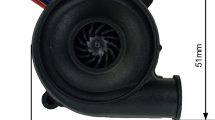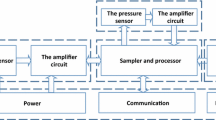Abstract
In this paper, a treatment of respiratory disorders with brushless DC motor (BLDC) driven positive airway pressure (PAP) respirator is developed. The proposed schema of the system consists of a BLDC motor driven blower fan aided by a MEMS capacitive type pressure sensor to measure respiration rate (RR). To measure the respiration rate, the array of such sensors are mounted below right nostril (RN) and left nostril (LN), in such a way that the nasal airflow during inspiration and expiration impinge on the sensor diaphragms directly. Due to irregularities in nasal airflow in some respiratory diseases, the RR varies from the normal rate (12–20). Thus, a supporting airflow regulatory system has been designed to reduce abnormalities in RR. The supporting system consists of a positive airway pressure (PAP) respirator with a blower fan to relieve patients breathing abnormalities. The MEMS based RR sensors help to monitor patients breathing rate continuously and finally maintain the required air pressure/flow by regulating the rpm of the blower fan through BLDC motor drive. In order to implement such a control action, we have chosen the sensorless drive of BLDC motor to construct a transportable as well as noise immune system. An algorithm has been developed to sustain normal RR for both bradypnea (RR < 12) and trachypnea (RR > 20), which puts into operation through ATmega 328 to facilitate high level precision controlled action. The control system alongwith the sensory part occupies limited space in few centimeters with light weight. As a result, the electronics of the whole system can be easily mounted at the outer surface of the tube connected with the nasal mask. The scheme of such a portable and cost effective system is described in this present work.












Similar content being viewed by others
References
Choi S, Jiang Z (2006) A novel wearable sensor device with conductive fabric and PVDF film for monitoring cardiorespiratory signals. Sens Actuators A: Phys 128:317–326
Chowdhury Debjyoti, Chattopadhyay Madhurima, Roy Priyanka (2013) Modelling and simulation of cost effecive sensorless drive for brushless DC motor. Proced Technol 10:279–286
Farre R, Montserrat JM, Navajas D (2004) Noninvasive monitoring of respiratory mechanics during sleep. Eur Respir J 24:1052–1060
Folke M, Cernerud L, Ekstrom M, Hok B (2003) Critical review of non-invasive respiratory monitoring in medical care. Med Biol Eng Comput 41:377–383
Ghafar-Zadeh E, Sawan M (2008) Charge-based capacitive sensor array for CMOS-based laboratory-on-chip applications. Sens J IEEE 8(4):325–332
Oum JH, Lee SE, Kim D-W, Hong S (2008) Non-contact heartbeat and respiration detector using capacitive sensor with Colpitts oscillator. Electron Lett 44(2):87–88
Manjunatha RG, Ranjith N, Meghashree YV, Rajanna K, Mahapatra DR (2013) Identification of different respiratory rate by a piezo polymer based nasal sensor. IEEExplore 978-1-4673-4642-9/13.
Milic-Emili J (1982) Recent advances in clinical assessment of control of breathing. Lung 160:1–17
Moffett D, Moffett S, Schauf C (1993) Human physiology. Chapters 13 and 16., 2nd edn. Wm. C. Brown Publishers, Dubuque
Prkic I et al (2012) Pontine μ-opioid receptors mediate bradypnea caused by intravenous remifentanil infusions at clinically relevant concentrations in dogs. J Neurophysiol 108:2430–2441
Sharma A (2008) Modelling of a pull-in voltage and touch point pressure for MEMS capacitive transduces with square diaphragm. Ph.D., thesis, Kurukshetra University, Kurukshetra
Siivola J (1989) New non-invasive piezoelectric transducer for recording of respiration, heart rate and body movements. Med Bio Eng Comp 27:423–424
Weigt SS, Abrazado M, Kleerup EC, Tashkin DP, Cooper CB (2008) Time course and degree of hyperinflation with metronomepaced tachypnea in COPD patients. COPD 5(5):298–304. doi:10.1080/15412550802363428
Acknowledgments
Author Madurima Chattopadhyay likes to acknowledge Department of Science and Technology, Govt. of India for financial support from the First Track Young Scientist scheme to carry out the research work.
Author information
Authors and Affiliations
Corresponding author
Rights and permissions
About this article
Cite this article
Chattopadhyay, M., Chowdhury, D. A new scheme for reducing breathing trouble through MEMS based capacitive pressure sensor. Microsyst Technol 22, 2731–2736 (2016). https://doi.org/10.1007/s00542-015-2707-0
Received:
Accepted:
Published:
Issue Date:
DOI: https://doi.org/10.1007/s00542-015-2707-0




